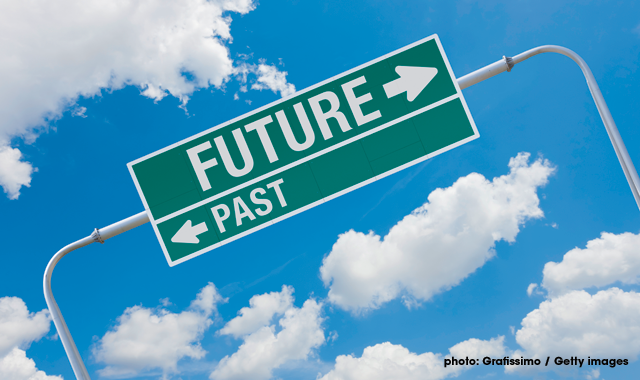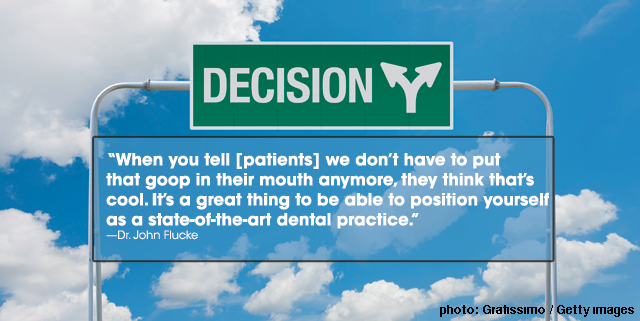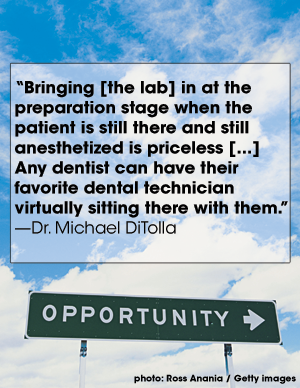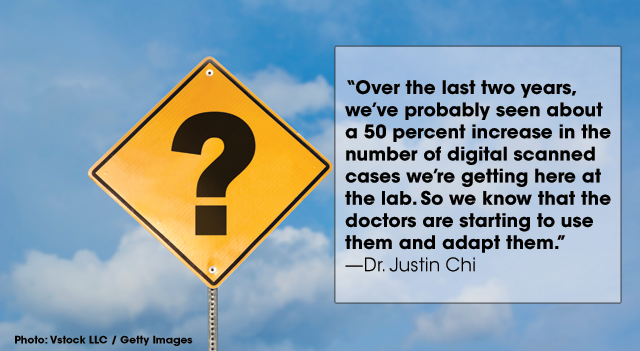Are digital impressions REALLY the better choice?
In their August 2016 cover story, Dental Products Report looks at digital impression systems, focusing on how intraoral scanning systems are changing the workflow for dentists.

For years, dental experts have been telling dentists that intraoral scanners were going to be the wave of the future. That future is now here-the scanners are cheaper than ever, more available than ever and easier to use than ever. But are they worth the investment? Are digital impressions really that much better of a choice than traditional impressions? And will they help you practice better dentistry?
Digital impressions offer amazing possibilities for dentists, from better patient experience to better restoration outcomes. Intraoral scanning enhances the workflow for the practice. For some dentists, taking digital impressions has even enhanced their clinical skills.
However, some would argue the benefits of digital impressions are not worth the pain of change. The advantages simply don’t outweigh the drawbacks and expense of switching from traditional impressions.
Must read: 5 reasons to use intraoral scanners
“Anyone that practices dentistry is aware that the current method of taking impressions-polyvinyl and polyether impressions-works just fine,” explains Dr. Mike DiTolla, Dentsply Sirona, Director of Clinical Affairs. “It’s easy to do. Every dentist knows how to do it and it’s not broken. You have to see what the advantages of digital are because they need to be significant to get you to change from something you’re familiar with that is already working.”
So, who is right: The people who are just fine with traditional impressions, or the people who tout the digital method? At this point, the jury of clinical opinion is still deliberating. In the meantime, let’s explore that question in several ways and learn how intraoral scanning is playing out in the real world of clinical practice.
The advantages digital impressions offer the clinical approach to preparation
The marketing message of digital impressions is clear: Digital impressions have huge advantages over traditional impressions. They have a higher clinical success rate when compared to traditional impressions. Digital workflows increase efficiency by streamlining the production of restorations and reducing the need for remakes. Digital scans never degrade, can be reused, are easily stored with your digital patient files, indefinitely, and sometimes are accessible anywhere you have an internet connection. Furthermore, digital impressions create a better patient experience by eliminating the need to bite into a tray of impression material, sometimes more than once and over the course of three appointments.
However, the initial advantages the clinicians using digital impressions in their practice mentioned veered from these common marketing messages, sometimes in surprising ways.
Dr. DiTolla believes there isn’t a faster or more efficient way to become a better clinical dentist than with using digital technology: “The biggest quantum leap that I made in my clinical skills was years ago, back in 2007 when I got involved with my first digital impressions system,” he explains. “I could now capture my preparations and blow them up on the screen. I could see what I was doing to a level I never saw when I was looking in the mouth, even with my loupes on.”
Carrie Nelson, Director of Marketing Planmeca USA–CAD/CAM, also describes digital intraoral scanners as a teaching tool for dentists because the immediate production of an image improves the clinician’s approach to preparation: “They can see where they’ve missed something or where they haven’t prepared all the way. Then they can go back in, fix the preparation and rescan.”
Dr. John Flucke, who has been in private practice for 29 years, agrees. “The ability to see the work on the screen lets you prep better,” he says. “The ability of the device to tell you when it’s checking the prep and the occlusions or that in this area the bite is a little close and that you need to make an adjustment-that’s huge.”
Step-by-step technique: A complete workflow, from chairside to patient mouth
Digital impressions allow for a quick turnaround on the crown, especially for dentists doing chairside dentistry. “For dentists doing in-office milling, digital impressions can eliminate a patient from needing to make another visit to the dentist to get their crown,” explains Josie Bunning, U.S. Procedure Marketer for Digital Equipment at 3M Oral Care.
However, the benefits for quick turnaround are apparent even when the restoration still goes to the lab. Labs receive the impression the same day, even the same hour, after you finish prepping the tooth, which means they can produce the crown(s) or appliance faster. Dr. DiTolla discovered that by seating the crown days instead of weeks later, he had fewer adjustments.
“It’s the most significant thing I’ve ever done to decrease my amount of adjustments,” he says. “And I’ve talked to many other dentists who have found the same thing to be true.”
Next page: What improvements do digital impressions offer?
Improving what traditional impressions offer
These advantages are excellent. However, they don’t change the fact that traditional impressions are working. So what do digital impressions offer that traditional impressions don’t?
Dr. Justin Chi, Clinical Research Associate at Glidewell Laboratories, prefers digital impressions because they have a higher clinical success rate than traditional impressions. However, this success rate requires diligence on the part of the clinician to maintain proper preparation with clearly visible margins and occlusion, as well as a good feel for the contacts needed.
News: 3Shape's TRIOS scanner gets the OK for Invisalign
“When done correctly, there is no doubt that digital impressions reduce the remakes due to margin issues,” he explains. “They also reduce remakes due to fit issues and also high occlusion complaints. In the right hands and with the right digital workflow, digital impressions help increase clinical success and reduce remakes.”
Bunning notes that, unlike a traditional impression, you can stop and start. This fact is helpful if the case requires capturing several profiles and margins at one time, or if you encounter bleeding or insufficient retraction. “You don’t have to capture everything at once. If the patient needs to take a break, you can pull the wand out and then continue on,” she explains. “This allows flexibility from a workflow standpoint.”

One of the big advantages is that digital impressions are repairable. If you use a polyvinyl impression material and you get a bubble, you take a second impression. But if you’re taking a digital impression and you get a distortion, you circle that area, scan it again, and the software stitches it together.
Digital impressions also make apparent what can be missed by the naked eye in a traditional impression process, like bite registration or whether there are proper reductions on the occlusion. Nelson explains how the level of visibility digital impressions produce, as well as software enhancements that aid in clinician’s analysis, reduce remakes at the lab.
“When the final impression is scanned and the bite registration is obtained, the virtually articulated model of the preparation is visible to them,” she notes. “Our system can indicate with colors any areas where there’s inadequate reduction. It makes it possible for the dentist to see insufficient prepped impressions and because of that there should be a noticeable reduction in remakes from the lab.”
Deep dive: How CEREC can help orthodontic treatment
Before going digital seven years ago, Dr. Flucke took only traditional impressions for 22 years. However, once his practice started using the iTero scanner, he moved to taking nearly all impressions digitally in less than 90 days. Why? He credits a fast learning curve along with a decreased need for impression retakes.
“People will say, ‘Well, there’s no reason to switch.’ I think there are a lot of reasons to switch,” he says. “The efficiency is nice. The final restorations are so much quicker, much easier, much better, which is something I didn’t believe when we first starting doing it, but is true. There are a lot of intangible advantages to doing this. I definitely would not go back.”
Next page: What do patients think?
What do patients think?
Few would argue that the intraoral scanner isn’t a better experience for patients. Traditional impressions can be stressful for patients, and as a result, can be uncomfortable for the dentist or assistant taking the impression.
“People don’t like biting down on the gummy stuff,” Nelson observes. “It sticks to your teeth and it promotes the gag reflex when you’re using the regular impressions. The digital impression takes that away completely.”
Dr. Flucke says getting away from impression material has been a big positive for his patients: “If we tell them we could use impression material or we could use this machine, they say, ‘Give me the machine!’ ”
Related: 5 reasons why you should use an intraoral scanner [Sponsored]
Dr. Chi has had a similar experience with patients. He thinks patients prefer digital scans because there is no impression material needed, just a quick scan with a wand. But he says he also thinks patients like the digital method because it makes seating the crown easier.
“It’s just taking a picture. And then, when the patient comes back, the crown goes right in. It’s a quick, 30-minute appointment,” Dr. Chi says.
Dr. Flucke’s cementation appointments are also easier than they were using traditional impressions. He describes a period where he had 12-15 single-unit cases where he didn’t have to touch the final restoration: “It was just a case of: Put it in; the margins look great. Check the contacts; the contact feels great. Have the patient bite. How does it feel? It feels perfect. And then they would get on down the road.”
Dr. DiTolla adds that investing in technology creates a better patient experience. He compared it to his recent eye appointment where the doctor no longer needed to dilate Dr. DiTolla’s eyes because the eye doctor had invested in a piece of equipment that could get the same information without dilation.
“He said it’s an extra $20 charge. I said, ‘$20? I’d pay $40 not to have my pupils dilated for the next hour,” he says, laughing. “So I was really happy that they had that technology. It’s the same with dental patients. When you tell them we don’t have to put that goop in their mouth anymore, they think that’s cool. It’s a great thing to be able to position yourself as a state-of-the-art dental practice.”

Bunning agrees that technology can appeal to a certain patient type, which then leads to better word-of-mouth advertising.
“We hear that patients think digital impressions are really neat and take pictures of their scan and share on social media,” she says.
Justifying the expense
One of the main objections clinicians have about switching to digital impressions is the expense of buying the system. It’s no secret that dental income has been flat for years. When you consider that the price of doing business is always climbing, it’s easy to understand why dentists are cautious when it comes to investing in new technology.
However, digital workflows and digital impressions aren’t the first time that a technology investment changed the way dentists practice dentistry.
“Think back to digital X-ray,” Dr. Chi says. “It took doctors a long time to switch over to the digital X-rays. The first digital X-rays were super expensive. The cost of entry was huge and it didn’t work all the time. I’m sure all doctors use digital X-rays today, but it took a long time for that to happen.”
According to Orthodontic Products’ June 2015 issue, scanner units range in price anywhere from $16,000 to $55,000 (click here to download the PDF of Orthodontic Products' comparison). Additional charges can include the software fees, which can be an annual charge ranging from around $2,000 to $4,000, or a monthly fee that ranges from $200 to $330 per month. Some scanners include the software for the first year (such as the iTero Element), charging a monthly fee after that. Some scanners (Carestream’s CS 3500, Ormco’s Lythos Digital Impression System and CEREC AC Connect with Omnicam) have no software fees. Many of the scanners include a warranty for the first year, although a couple do not, choosing instead to include it as part of the monthly software fee. After the first year, many have an additional charge for the warranty.
Next page: Figuring out the ROI ...
The cost-benefit analysis of digital impressions is tricky, as some advantages digital impressions afford do not translate to a specific dollar amount. However, one direct calculation is the reduction in lab fees. Glidewell Laboratories, where Dr. DiTolla practiced for 15 years, offers a 20 percent discount to clinicians that send them digital impressions. He said other labs have invested in the digital technology on behalf of clinicians or offer discounts like Glidewell Laboratories does. “Laboratories are in love with this technology because it makes their life a lot easier,” he says.
News: Straumann announces new intraoral scanner
Nelson points out there are costs associated with traditional impressions. Dr. Flucke agrees, adding that the costs of traditional impressions are skewed because sometimes dentists underestimate their costs.
“We say ‘Oh it costs us X dollars to take an impression,’ but we don’t think about how many times we take two impressions,” he says, “or how many times we take three. It’s probably not that common for a lot of people, but it does happen and we don’t factor that in.”
“The case management improvement and time savings are the true advantages of digital impressions,” Nelson explains. “Also, digital impressions show an excellent margin capturing visibility. It enables us to capture the prep in great detail, it facilitates fabrication and it contributes to the minimal need for dentists to make adjustments in the final restoration. Digital impressions also take less time, so that means dentists can get more patients and produce more work in the practice.”
Dr. DiTolla cautions clinicians to be careful of not thinking too narrowly about the potential afforded by digital impression technology. Impressions are only one part of what they do. Describing the benefits to prep technique and lab workflow as huge, he jokes that each time a dentist takes a digital impression, he or she should get an hour of Continuing Education credit because one learns so much about technique.
“I don’t know how to put a price on becoming a better dentist and having lower remakes,” he notes. “It’s something that every dentist should want to do anyway regardless of financial costs. It’s tough to put a dollar amount on that. Sometimes you just do things because it’s the right thing to do.”
While the learning curve can be different for every person, the majority of dental practices master intraoral scanners in a short amount of time. Most practices are comfortable with scanning after a few practice runs.

“With the 3M True Definition Scanner, the doctor receives eight hours of in-office training learning how to scan,” Bunning says. “We also encourage the dental assistant to take part in the training as well. By 10 scans, we see doctors feeling comfortable with scanning.”
Dr. Flucke, who currently uses the iTero Element model, agrees. “When we initially trained on our first iTero unit, they sent somebody out to the office,” he remembers. “They were here maybe five or six hours at the most and we had it. And that was to train all the dental assistants and both doctors.”
Some companies still engage in-office training techniques. However, more are adopting a virtual training approach online. What many clinicians are learning is that the user experience doesn’t change that much as the models upgrade and that additional training isn’t necessary.
Product release: The latest imaging solutions from Carestream Dental
“The key is to keep using the scanner and not put it in a corner. The more a dentist and staff uses the scanner, the more comfortable they will get,” Bunning says.
Enhancing the traditional lab-dentist workflow
Every one of our experts emphasized a boon for digital impressions was the increased communication and collaboration they facilitate with the dental lab. From catching problems before milling the restoration to collaborating on the best approach for treating special cases, the traditional lab-dentist workflow is changing for the better.
“Bringing [the lab] in at the preparation stage when the patient is still there and still anesthetized is priceless in terms of doing fantastic, esthetic restorative dentistry on anterior teeth,” Dr. DiTolla says. “With digital technology, any dentist can have their favorite dental technician virtually sitting there with them looking at the case before it’s going to be impressed.”
Next page: Why one clinician says digital impressions let him have a technician looking over his shoulder ...
Bunning agrees, adding that the increased communication between clinician and lab changes the traditional model of lab-dentist workflows. The digital workflow encourages early collaboration for treatment requirements. “Intraoral scanning has created the opportunity for both the dentist and lab to view a case online to discuss treatment and restoration options or special case requirements,” she notes.
Dr. DiTolla describes that through online conferencing, a dentist can have their technician viewing the impression process as it happens. “The technician watches you take the impression and says ‘Can you get a few more images of tooth #8 and #9? Okay, that looks perfect. Send it off to me. Thank you.’ That’s true teamwork,” he says.
According to Nelson, digital communication builds a better relationship between the lab and the dentist. The turnaround time is faster, and the online nature of the product saves time and money. It also opens up clinicians’ ability to handle bigger and better cases. The increased communication means the lab can open a file, ask a question faster and move on. Also, digital impressions make the transfer of files uncomplicated.
“It’s a huge benefit in terms of streamlining the whole process,” she explains. “No more delivery back and forth. It reduces the cost they’d been paying to send and deliver things to and from the lab. So there are huge time savings and huge costs savings overall.”
Dr. Flucke has had a great working relationship with his local lab for more than 20 years. He describes how having a digital workflow with his lab has made it like having his technician looking over his shoulder and helping solve problems before they start.
Related reading: How digital scanning increases spead and convenience
“He can bring it up right on his desktop and I can ask him, ‘What do you think of the distal lingual? Have you got a margin there? Because I think it’s there, but I’m not sure and I don’t want to make your job harder. Tell me what you think,’” he says, “We can go over that before anything gets out of whack and that’s cool.”
Bunning says the changing workflow with the lab is only the beginning. Workflows might have focused on crowns and bridges in the past, but the evolution in digital technology facilitates implants, orthodontics, dentures and 3D printing. In addition, open intraoral scanners create opportunities with low-cost mills, paving the way for the proliferation of chairside systems.
“Overall, there will be more seamless integration of the various devices and software allowing greater flexibility and workflow options for dentists and labs,” Bunning says.
Whether all the advantages of digital impressions are worth making the switch is something clinicians must decide for themselves. However, more dentists do feel they are worth it. Dr. Chi and his team have noticed at the lab that these advantages are gaining traction in the dental community.
“It’s catching on,” he says. “We’re starting to see our units increase from scanners. Over the last two years, we’ve probably seen about a 50 percent increase in the number of digital scanned cases we’re getting here at the lab. So we know that the doctors are starting to use them and adapt them. And it’s across all scanners, not just CEREC, not just Cadent (Align Technology’s iTero). Not just TRIOS, but all of them.”